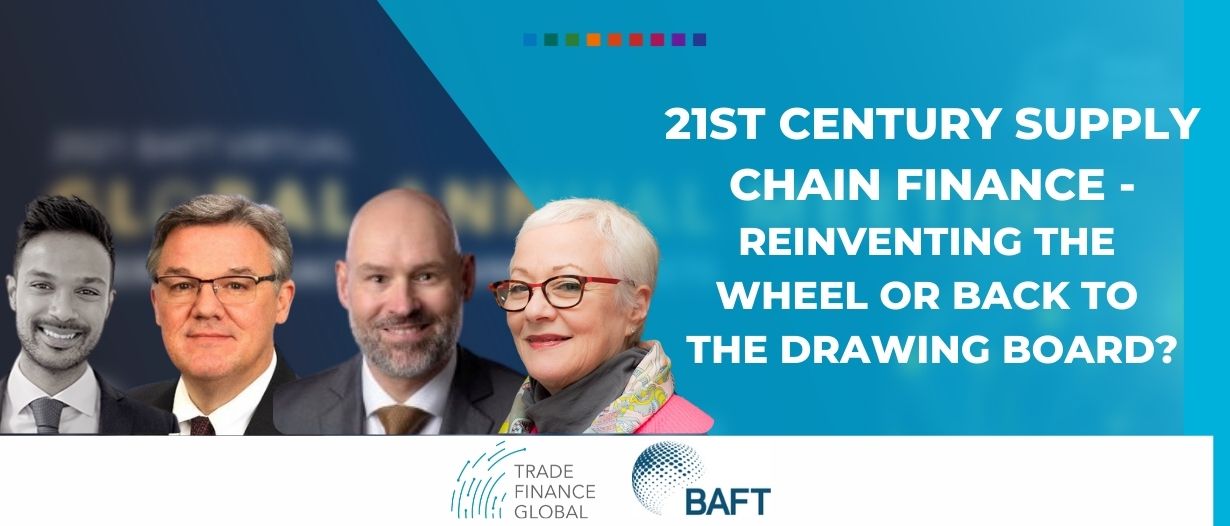TFG’s editor, Deepesh Patel had the pleasure of speaking with Stacey Facter from BAFT, Christian Hausherr from Deutsche Bank AG and the Global Supply Chain Finance Forum and John Monaghan from Citi Treasury and Trade Solutions at BAFT’s Virtual Global Annual Meeting.
The panel moderated explored the evolution of Supply Chain Finance techniques, from many different perspectives, highlighting its core principles.
Key Supply Chain Finance techniques
The Global Supply Chain Finance Forum (GSCFS), which aims to set commonly agreed standard market definitions for Supply Chain Finance and SCF-related techniques, differentiates between two large categories of Supply Chain Finance techniques: the receivables purchase category the loan base category.
The receivables purchase category includes techniques such as payables finance, receivables finance, factoring and forfaiting. The factoring technique, despite not currently being one of the most popular techniques still takes up a large portion of the market. Nevertheless, the market does appear to have a larger appetite for payables finance and corporate payment undertaking. The latter technique is similar to payables finance, at first glance, however, there are some slight but very important differences. One of them being that with a corporate payment undertaking, there is no receivables purchase and that is the reason why it’s not part of the receivables purchase category.
Benefits of Supply Chain Finance
Supply Chain Finance (SCF) encompasses several different financing techniques, as previously mentioned, and presents a cash flow solution that enables businesses to free up working capital trapped in global supply chains. Therefore, it should come as no surprise that SCF presents numerous benefits for both corporates and banks.
For instance, it offers the buyers the ability to extend their days payables outstanding (DPO), without the adverse effect on the sellers day sales outstanding (DSO). This presents a win-win situation for both buyers and sellers. It allows for much more predictable product availability for the buyer avoiding any disruptions in the supply chain activities as well as allowing sellers to receive early payment through a new source of financing without having to rely on local lending banks, without needing to post collateral and receiving better rates than they might receive from local banks.
Banks benefit from this financing technique too, however. Transactional banking, providing payment solutions, liquidity solutions and financing solutions to corporate clients is one of the most important parts of banks’ business models. As the SCF market has evolved so have the clients’ preferences. The market has moved from utilising traditional letters of credit to finance supply chains, to now preferring open accounts.
This has enabled financial institutions to provide services to their clients and their supply chains, be it customers, vendors or suppliers, without needing to have the customer relationship on either side of the corporate clients.
Trade finance has generally been defined as short term and self-liquidating, presenting advantages when looked at from an asset class point of view. On the financing side, when analysing economic cycles, and more recently, the pandemic disruption, it was found that SCF assets are particularly resilient in terms of defaults and more importantly, in their ability to recover in the event of a default. This was particularly important for banks during the Covid-19 period.
Cooperation is the way forward
It would appear that despite the multitude of negative impacts that the pandemic had on global markets, global trade and international relations, it did, however, highlight one crucial pre-requisite for harmonious development: cooperation. The panel discussed at length the need for cooperation in all industries, particularly, in the SCF.
This is not a new notion, however, as in 2014, a handful of industry players came together to discuss the development of SCF and its exponential growth for the trade business. As more businesses appeared with their own range of SCF products and solutions it became clear that the growing industry needed a baseline nomenclature to allow, not only industry insiders to discuss it, but also to facilitate discussions with regulators and investors. As a result, experts and bank associations came together to create just that… in a one-hundred-page document. To this day, SCF stakeholders still use these definitions in relevant industry dialogue, further highlighting the crucial role of cooperation in the continued development of the industry.
Since then the Global Supply Chain Finance Forum has:
- published guidances on receivables discounting and payables finance
- been working on the adoption of ICC rules for Supply Chain Finance
- provided guidance to the European Commission

BAFT and the Global Trade Industry Council
The pandemic shone a light on many supply chain challenges, luckily, BAFT through one of its leadership councils – the Global Trade Industry Council (GTIC) had the foresight to organise a group of Supply Chain Finance experts to create a document on how a strong framework for the payables finance programme would work.
In “ Payables Finance Principles”, GTIC outlined the detailed structure, the roles and responsibilities of each stakeholder, the documentation required and the practical application of the SCF payables finance product. Therefore, providing the industry players, corporate buyers, suppliers, regulators, standard-setting bodies, government agencies, accounting firms, and rating agencies, with a stronger, more complete understanding of how the product is meant to work or to be beneficial to buyers and sellers.
The importance of regulatory bodies in payables finance
In 2018, the big four accounting firms asked the Financial Accounting Standards Board (FASB) to review the technique called payables finance, also known as reverse factoring and to weigh in on the balance sheet and financial statement requirements for the product. Similarly, the International Financial Reporting Standards (IFRS) was approached by one of the rating companies with a similar request, kicking off a complete product review at each of the US and EU financial standards bodies.
The FASB and the IFRS played a crucial role in the regulation and standard creation for the industry- their work is not done, however. They are now in the final stages of reviewing what disclosure requirements should look like for corporates using these programmes to provide transparency -an increasingly more prominent issue around the product-, minimise liquidity challenges and offer all information available for the investor community.

Does Supply Chain Finance have a bad reputation?
Supply Chain Finance has, recently, been under increased scrutiny, as a result, this was a particularly important issue for the panel to weigh in on. The panel highlighted that, despite, the high profile bankruptcies that have taken place, it is crucial to keep in mind that the SCF is an umbrella definition, encompassing a variety of topics on both the receivable and payables side.
There is, however, still work to be done to ensure that market participants have access to the necessary information to be able to distinguish between payables finance and other techniques, the documentation involved, the benefits and why one technique might be used in favour of another. Therefore, the role of regulatory bodies becomes all the more pressing.
Furthermore, the panel discussed how SCF is perceived as a tool in the blockchain industry and, how the main aim is to close the infamous financing gap in SCF.
What is next for SCF?
The GTIC is currently working on a third category entitled “advanced payables”, encompassing three financing techniques: bank payment undertaking, dynamic discounting and corporate payment undertaking.
The corporate payment undertaking technique would directly address certain limitations of, for example, the onboarding process. The primary limitation being since no receivable is purchased in these techniques, is the payable in the book of the corporate regarded as a trade payable or as a bank debt? This technique directly addresses this issue by clearly stipulating how it should be regarded.
Dynamic discounting consists of an agreement between the buyer and the seller, where a service provider can calculate a discounted price and for the buyer to simply pay earlier. Over the past years, dynamic discounting has become more relevant, which combined with a surge in the cooperation between banks and fintechs indicates dynamic discounting appetite will continue to grow. As dynamic discounting is less regulated it is only logical to want to create smart offerings to market participants depending on their working capital needs.
Lastly, a bank payment undertaking is a form of deep tier financing, where a payment can be funded by anyone as it has already been guaranteed by the adopted bank, ensuring the buyer or seller’s liquidity.
Technology in deep tier financing
Pre-shipment and PO finance is another area of interest. The question of whether an anchor client can help support the lending decisions of a financier in deep financing is highly debated in the SCF space. Advances in blockchain technology may introduce the level of security and information needed for lenders to become more comfortable with this type of finance. As market appetite continues to grow so will blockchain and AI innovations, so this is certainly an area to keep an eye on.

ESG and Supply Chain Finance
SCF, the panel argued, can deeply help companies to achieve their ESG goals and have a positive environmental impact. Companies are shifting towards using SCF programmes to ensure their vendors are acting sustainably and in a socially responsible manner. This shift comes with a surge in the number of companies announcing Supply Chain Finance ESG initiatives, The increased interest in ESG and ESG related initiatives is also likely to culminate in the creation of an environmental financing technique as well as an ESG friendly asset class.
The panel agreed that sustainability and its influence on SCF are likely to continue to be explored and deeply and positively impact the industry.
Payable finance programmes without extending terms – good or bad?
Though it is not common practice to roll out payable finance programmes without extending terms, it is becoming increasingly more common in the industry. This is no cause for alarm, however, since, as the panel highlighted it might introduce liquidity into supply chains.
Not extending terms may provide suppliers with needed liquidity, perhaps at a lower cost than they would find elsewhere. Additionally, this may also reduce the possibility of supply chain disruptions, resulting in a more stable supply chain. This is not only beneficial for the suppliers, however. The seller may also benefit from an extension of the term of payment as it may be a more attractive financing condition to suppliers, for instance- it is a win-win situation. The buyer may pay a little later, however, the seller will still get their funds early while paying less than the old payment terms, even if they’re both shorter. Furthermore, the seller may be interested in stabilising the supply chain by ensuring their strategic sellers are supported and liquid.
In summary, there is no need to go back to the drawing board due to the continued work of regulatory bodies and BAFT to ensure the SCF industry continues to grow in a manner that is beneficial for both corporates and banks.

































